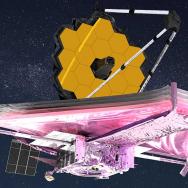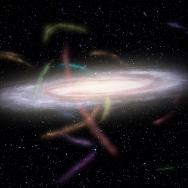The first images of the universe captured by NASA’s new flagship telescope, the James Webb Space Telescope, are worth more than a thousand words.
The images, released July 12, show nebulas, galaxy clusters and exoplanets in unprecedented and stunning detail.
The telescope, commonly referred to as JWST, launched last December off the coast of French Guiana. It is the successor to the Hubble Telescope, but larger and even more complex. In the months since it launched, it has gone through a complex process to unfold and calibrate itself, settling into its spot in orbit a million miles away from Earth.
“These are some of the sharpest images of the universe ever taken by humanity,” said University of Chicago astrophysicist Michael Gladders, who is part of several international teams taking data with JWST in these first few months.
“Looking at these images reminds me why I’m in this business—why I devote my time and energy and life to this kind of research,” he said, “because there are moments like this where it’s just extraordinary.”
As the telescope ramps up its observations, scientists expect a flood of fascinating data. The JWST is specifically designed to pick up infrared light, which has longer wavelengths than visible light. Because light gets stretched longer and longer as it travels across the universe, much of the oldest light from the beginning of time is infrared.
That means scientists can ask questions like what the universe looked like in its infancy and how it developed. It will also be able to reveal new details about what kinds of other planets are orbiting faraway stars.
“The detail in these JWST images is simply spectacular,” said UChicago astrophysicist Wendy Freedman. “It's as if we are putting on eyeglasses and suddenly seeing fine detail for the first time.”
Freedman is planning to use findings from JWST to make new estimates for how fast the universe is expanding, a measurement known as the Hubble constant. “This telescope is opening a new window on the universe,” she said. “I can't wait for the new discoveries that will come.”
UChicago astrophysicist Hsiao-Wen Chen saw a half-dozen research topics just in her initial glance at the newly released images.
“We are seeing literally the first generations of stars after the universe began,” she said. “It’s incredible.”
She is planning to use data from the telescope to study mysteries such as the supermassive black holes that appear to have formed surprisingly early in the universe.
The telescope's success is especially sweet after the nails bitten around the world as it launched; there are thousands of things that could go wrong when shooting a delicate instrument into space atop several hundred tons of rocket fuel.
But the launch went perfectly. In fact, JWST’s deployment has gone so well that astronomers hope the telescope can run for even longer than the initially planned five years. The spacecraft is limited by the amount of fuel it carries, but the launch and journey so far have been so efficient that there is quite a bit of fuel left, which could mean the telescope might be able to run for ten or more years. “That means we’ve been able to think about what kind of observations we could do over the long run, not just scrambling for everything we can get in the first few years,” said Gladders, who plans to use JWST to peer back at the earliest galaxies in the universe to understand how they formed.
Other University of Chicago scientists who have been allotted telescope time in JWST’s first observing cycle include astronomers Alex Ji—who will use the telescope to look for the aftermath of a neutron star collision if one is detected—and Jacob Bean, who is trying to find out more details about exoplanets orbiting other stars, such as what they look like and whether they might be able to host life.
But the new images and data coming from JWST can be appreciated by everyone.
“After all, NASA is funded by taxpayers,” said Gladders. “So I think it’s true that everyone in the country made a little contribution to it.”

